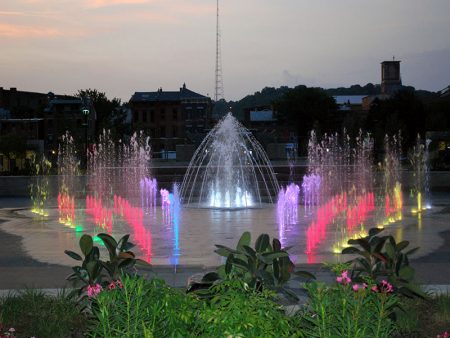
Photo c/o Rheingeist Brewery
Two cathedrals have recently arisen in the Over-the-Rhine area of Cincinnati’s urban basin, one a renovation of an historic brewery, the other a fountain complex in the center of the newly redesigned and constructed Washington Park, across from Music Hall, the chief landmark of the neighborhood, which has also been renovated and restored in a major cultural campaign. Neither “Cathedral” is a religious institution, but both have visual and metaphorical resemblances to the sacred edifices of the Middle Ages.
The first such visionary minster is Rheingeist (“Ghost” or spirit of the Rhine
River), a vast bar complex on upper Elm Street, in our traditionally—but no longer—German-American neighborhood. An enormous red-brick shoe-box-shaped edifice with traces of German Romanesque Revival style in its flat facades, the structure was converted recently from a long-vacant 1895 Moerlein Beer brewery to an amazingly popular gathering place, mostly for young people. The scale of the upper interior space, on an elevated floor, is as grandiose as a cathedral’s: giant steel arches create “bays” and rise to an immensely high ceiling pierced by skylights; two huge and effective horizontal “Bad Ass” fans suggest giant rose windows; and there are lower “aisles” along the sides. The climax at one end of the space is a tall room-height compartment containing three shiny vertical beer tanks, framed like triple main and side altars, as if dedicated to Jesus Christ between Mary and Joseph in traditional Roman Catholic churches. Since there is no elevator (except an almost unfindable one only for physically challenged people and the few aged visitors) and the main space is about 40 feet above the street, with another 35 feet or so of steps up to the platform on the roof-top with its terrific views of OTR and the cityscape in its valley, the approach to this “cathedral” reminds me of the steps up to Immaculata Church on Mt. Adams that the devout climb up on their knees on Good Friday: a correlation of old and contemporary worship styles?

Photo c/o SAI Fountains, the designers and builders of the feature
My other cathedral is the layout of the fountains in Washington Park, also a focal point of the Over-the-Rhine gentrified neighborhood. For a baptismal font at its ”entrance,” there stands a low granite basin with an invisible central mini-jet that overflows with water and babies at all times. The 50 or so main fountains—congregants or columns–are arranged as a central-aisle and cross-aisles, all gently curved and leading to a veritable transept, like the spreading arms of Christ on the Cross. At its head, the whole array of rising and falling water-jets is crowned by a circular fountain that has stubby low jets forming an altar beneath a wonderful dome of graceful taller sprays—a moving baldacchino—that continually lifts above it: thin, gentle streams that soar like prayers to the Almighty and then droop downward to the ground, ever to rise again. A curve of oversized granite steps frames the “east end” of the dome, over-flowing with melodically rushing, rippling waters that evoke a choir.
Above all are the ever-changing, luridly-colored lights at the bases of the dozens of jets that might represent the congregation: they are like nothing so much as living stained-glass windows, Medieval or otherwise, or a diapason of colorful organ pipes: sometimes their play is coordinated with diverse music disseminated by loud-speakers, like jivey hymns. The fountain scene is usually enlivened by a dozen or more cupids or putti: children of various ages, colors, costumes fancy or minimal, and degrees of energy and inventiveness, plus the inevitable screams of terror or delight, whether mentored by their grown-ups or not.
And me as the hermit observing off to one side, admiring at evening the Gothic gables of Music Hall and the dazzling western sky-phenomena, dominated later in the dark as the fountain sanctuary is finally turned off–by the moon. One could even see the Imperial Roman Baroque façade of Memorial Hall, also visible nearby, as providing the grand entrance to the fountain sanctuary (as different as possible from the approach to Rheingeist, although which is more “spiritual” is hard to tell)!
–Walter E. Langsam is an architectural historian and writer who recently moved to the Over-the-Rhine neighborhood.
Walter, please continue to keep us entertained with your beautifully written articles of OTR.
How lucky the area is that you have moved there and bring things to our attention that may have been overlooked by our frantic lifestyles. Thank you.
Walter, please continue to keep us entertained with your beautifully written articles of OTR.
How lucky the area is that you have moved there and bring things to our attention that may have been overlooked by our frantic lifestyles. Thank you.